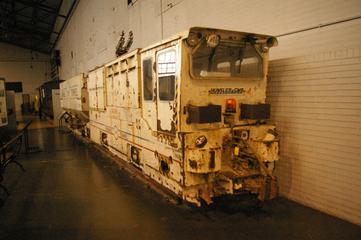
British Railways cattle wagon
- Made:
- 1951

Cattle Wagon, British Railways, 8T Cattle Wagon No B893343, 1951.
Until the 1960s, the railways were an essential link for transporting livestock between farm, port and market. By the mid-nineteenth century, the railways had removed the need to walk livestock over long distances. The cattle wagon was designed to ensure the animals remained in good condition for sale or slaughter for food. Many stations in agricultural districts had cattle docks for loading or unloading; farmers herded the cattle into and out of pens next to the wagons. The livestock was loaded to minimise movement and therefore injury during the journey.
From 1895 the government set specifications for cattle van construction to ensure the welfare of livestock during transit, with interiors free of projections that caused injury to the animals. These specifications were incorporated into the standard designs adopted by the Railway Clearing House. These changed little over several decades, and included a roof, planked ends and lower sides and an open upper portion of the sides for ventilation. Gaps were let into the lower planking to allow inspection and further ventilation.
Livestock traffic was labour-intensive and experienced seasonal fluctuations in Britain. This could impact upon service quality as the demand for wagons in a district could be high, and their distribution needed to be closely monitored by railway officials. This was exacerbated by the need to clean the vans after use. As an example, in 1929 the London & North Eastern Railway could not easily call upon its full complement of 7,183 cattle wagons to meet spikes in demand because the cleaning process meant a round trip could take up to six days. Furthermore, cattle wagons were also crucial for transporting imported livestock, the railway companies having also developed facilities for handling the routinely heavy port traffic.
The wagons, which came in small, medium and large capacities, included adjustable partitions for flexibility in operation. Before the Second World War, cattle wagons were often attached to passenger trains, with through-piping for steam heating and vacuum brakes fitted. An 8-ton wagon had an average capacity of seven head of cattle. Wagon No B893343 is a late example, having been built in 1951 by British Railways to replace life-expired pre-nationalisation types. By the time this wagon was built, cattle traffic was in decline on the railways as road haulage offered a flexible, door-to-door alternative.
Details
- Category:
- Locomotives and Rolling Stock
- Object Number:
- 1978-7111
- Materials:
- wood (unidentified) and metal (unknown)
- type:
- railway wagon
- credit:
- British Rail, Add. not known




